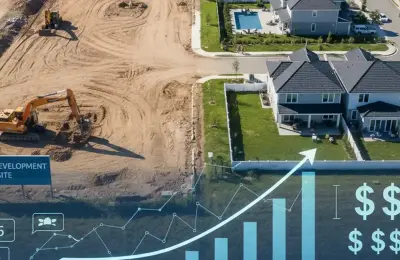
Starting a Property Development Business in the USА: The Entrepreneur's Guide

Property development is one of the most dynamic and lucrative sectors in the United States, offering significant returns for those who successfully navigate its complexities. It involves turning a raw idea into a tangible, profitable asset—from residential subdivisions to commercial complexes.
This comprehensive guide is designed for the aspiring entrepreneur looking to launch and scale a successful property development business in the competitive US market.
Phase 1: Planning and Legal Foundation
Before breaking ground, you must establish a solid legal and financial framework for your venture.
1. Define Your Niche and Strategy
The US market is vast. Specializing can significantly increase your chances of success.
Residential Development: Single-family homes, multi-family housing (apartments, condos), or specialized housing (senior living).
Commercial Development: Office buildings, retail centers, industrial warehouses, or hospitality (hotels).
Geographic Focus: Concentrate on a specific city, county, or state where you can build deep knowledge of local zoning and market demand.
Strategy: Will you focus on ground-up construction (new builds) or redevelopment/repositioning (acquiring and improving existing assets)?
2. Legal Structure and Registration
Choosing the right entity structure affects taxation, liability, and administrative complexity.
| Structure | Key Benefit | Tax Implications |
|---|---|---|
| LLC (Limited Liability Company) | Personal asset protection and flexibility. | Pass-through taxation (profits taxed only at the personal level). Most common choice. |
| S-Corp | Allows owners to be paid salaries, reducing self-employment tax exposure. | Pass-through taxation. Strict requirements apply. |
| C-Corp | Best for raising significant capital through outside investors. | Double taxation (taxed at the corporate level and again on dividends). |
Action Step: Register your chosen business name with the appropriate Secretary of State office and obtain an Employer Identification Number (EIN) from the IRS.
3. Licensing, Zoning, and Permits
Property development is heavily regulated at the local level.
Licensing: While property developers often don't need a specific 'Developer' license, you may need to hold or hire licensed General Contractors or Real Estate Brokers depending on your state's laws.
Zoning Due Diligence: You must become an expert in the zoning codes of your target areas. Zoning determines what you can build (e.g., residential vs. commercial) and how much (density, height restrictions).
Permitting: The process of obtaining building permits from local authorities (city or county) can be lengthy. Budget time and money for this crucial step.
Phase 2: Financial Planning and Capital Acquisition
Capital is the lifeblood of property development. Projects are often financed through a complex mix of equity and debt.
1. The Capital Stack
Successful developers leverage different funding sources to minimize risk and maximize returns.
Equity: The cash invested by you (the entrepreneur) and your partners/investors.
Sponsor Equity: Your own capital commitment (demonstrates skin in the game).
Investor Equity: Capital raised from high-net-worth individuals (HNWIs) or private equity firms.
Debt (Leverage): Money borrowed from a financial institution.
Construction Loans: Short-term financing (typically 12–36 months) used to cover the costs of construction. These are released in draws as work progresses.
Mezzanine Debt: A layer of high-interest debt that bridges the gap between the construction loan and the equity.
2. Crafting the Financial Model
A detailed financial model is essential for securing funding and assessing viability.
Key Metrics:
Projected Revenue: Based on the assumed price/rent per square foot (PSF).
Total Development Cost (TDC): Includes land acquisition, construction hard costs, soft costs (architects, engineering, legal), and financing costs.
Return on Equity (ROE): The primary measure of investor success.
Debt Service Coverage Ratio (DSCR): Crucial for lenders.
3. Investor Relations (IR)
If you plan to raise outside capital, you need a compelling offering.
Private Placement Memorandum (PPM): A legal document required by the SEC for sophisticated investors, outlining the risks, terms, and financial projections of the deal.
Phase 3: Project Execution and Management
Execution requires assembling a world-class team and meticulously managing the project lifecycle.
1. Build Your Core Team
You cannot do this alone. Your team must include experienced professionals.
Architect/Engineer (A&E): Responsible for design, blueprints, and ensuring code compliance.
General Contractor (GC): Oversees the entire construction process, manages subcontractors, and handles site logistics.
Real Estate Attorney: Essential for negotiating purchase agreements, handling due diligence, and navigating zoning/entitlement processes.
Lender/Banker: Your financial partner for sourcing debt.
2. Site Selection and Due Diligence
This is where projects succeed or fail.
Feasibility Study: An early assessment of a site's potential profit, market demand, and risks (environmental, geological, legal).
Title Search: Verifying clear ownership and identifying any existing liens or easements.
Environmental Review: Phase I (and potentially Phase II) Environmental Site Assessments (ESAs) are critical to ensure the land is not contaminated.
3. Construction Management and Risk Mitigation
Budget Control: Maintain strict control over change orders. Small, unplanned changes are the primary cause of cost overruns.
Schedule Management: Time is money. Use sophisticated project management tools to keep the A&E, GC, and permitting process on track.
Insurance: Secure adequate liability insurance and builder's risk insurance throughout the development phase.
Phase 4: Exit Strategy and Scaling
Every project must have a clear exit strategy defined before its launch.
Sell: The most common exit for residential or smaller commercial developments. You sell the completed asset to an owner-occupier or another investor.
Hold (Refinance): For income-producing assets (apartments, offices), you may refinance the construction loan into permanent, long-term financing. This releases equity (a process often called a cash-out refinance) that can be used to fund your next project.
Syndication: For larger projects, you may sell a majority stake to a major institutional investor while retaining a management role and equity share.
Scaling Your Business
To move from a single project to a sustainable business:
Reinvest Profits: Use the profits and fees generated by successful projects as your 'Sponsor Equity' for the next, larger deal.
Develop Process: Standardize your due diligence checklist, contracting process, and financial modeling to reduce the time spent on administrative tasks.
Expand Network: Continuously build relationships with new capital partners (investors) and reliable General Contractors.
Key Takeaways for the US Entrepreneur
Location is King, but Zoning is Queen: Know your local regulations intimately.
Capital Stack Discipline: Never start without securing all layers of financing.
Team Matters: Your success hinges on the quality and reliability of your General Contractor and legal counsel.
News insight
 Nov 18, 2025
Nov 18, 2025
Property Developer Earnings in the US Market: A Comprehensive Overview
Explore how US property developers earn money. Learn about profit margins (Residential vs. Commercia...
 Nov 18, 2025
Nov 18, 2025
What Is a Build-to-Rent (BTR) Development?
Discover what a Build-to-Rent (BTR) development is. Learn about this growing real estate model, its...
 Nov 17, 2025
Nov 17, 2025
Build-to-Rent: Transforming America's Housing Landscape
Explore how the Build-to-Rent (BTR) model is transforming the US housing market. Learn why instituti...
